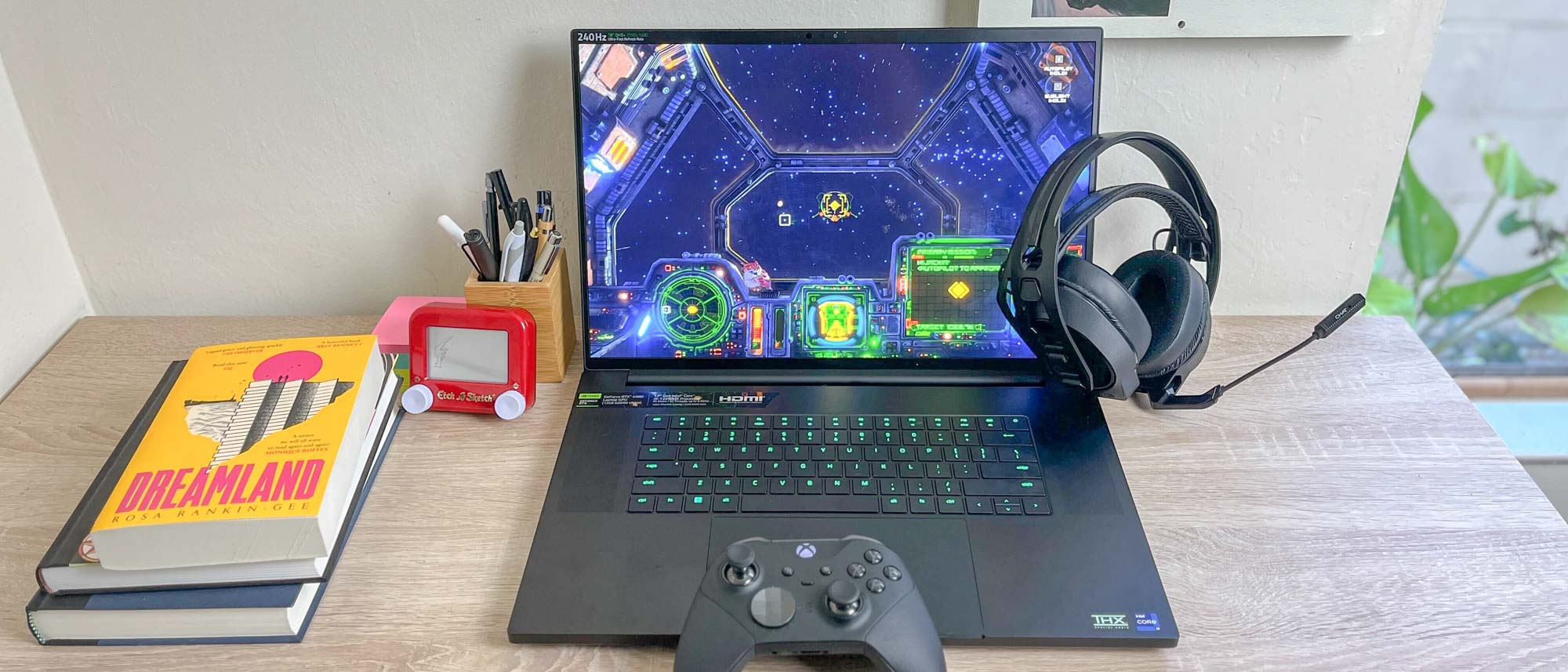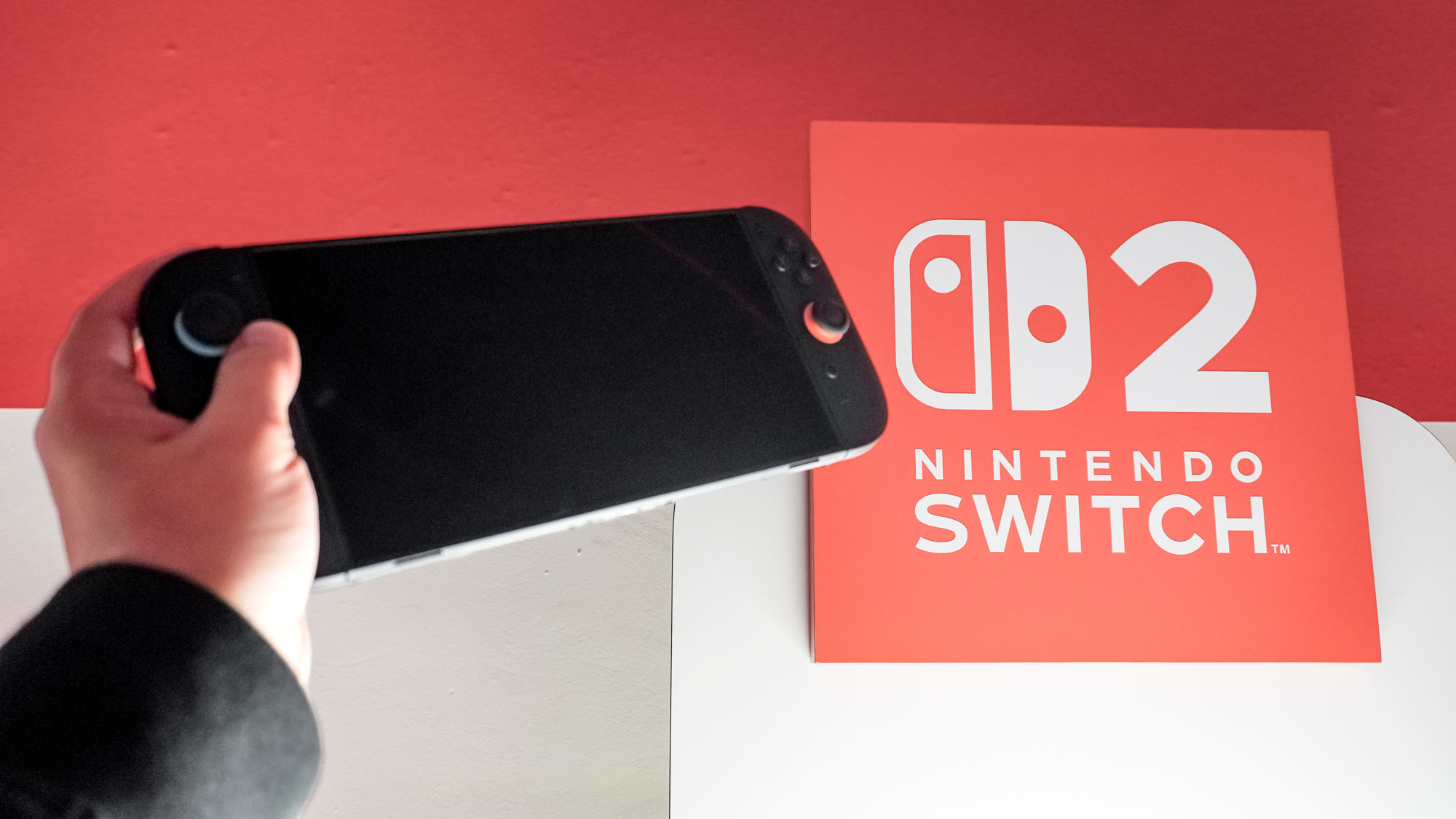Tom's Guide Verdict
The Razer Blade 18 is a strong argument for the existence of 18-inch gaming laptops, offering enough screen real estate and raw power to make the latest PC games look great. However, its poor battery life and sheer size make it ill-suited for gaming on the go.
Pros
- +
18-inch display is big and beautiful
- +
Potent RTX 4080 performance
- +
Plenty of ports
- +
Loud speakers
Cons
- -
Too heavy and unwieldy to carry easily
- -
Shallow, uncomfortable keyboard
Why you can trust Tom's Guide
Price: from $2,899 ($3,799 as tested)
CPU: Intel Core i9-13950HX
GPU: Nvidia GeForce RTX 4080
Display: 18-inch 240Hz QHD+
RAM: 32 GB
Storage: 1TB SSD
Ports: 3x USB-A, 2x USB-C (1x Thunderbolt 4), HDMI 2.1, SD card reader, Ethernet, 3.5mm audio
Dimensions: 15.74 x 10.84 x 0.86 inches
Weight: 7.05 pounds
The Razer Blade 18 ($2,899 to start, $3,799 as reviewed) is the biggest laptop Razer's made yet, and it makes a weighty argument for why you should buy a big-ass gaming laptop.
If you want a gaming PC you can throw in a bag when you need to, the Blade 18 is a solid choice. The 18-inch 240Hz QHD+ display seems as large and luminous as your average desktop monitor, making this laptop feel closer to a true desktop replacement than any gaming laptop I've ever tested. The streamlined design means it might not feel as hefty as you expect, but it's definitely not easy to carry around and isn't the best gaming laptop for folks who want to game on the go.
If you want a portable performance machine that's chiefly going to stay put, however, the Blade 18 is a great choice. The 18-inch display is nearly large enough to feel like a full-blown monitor, and the powerful 13th gen Intel Core i9 CPU and Nvidia GeForce RTX 4080 GPU inside give it enough muscle to play many games quite well. Unfortunately, it's not cheap, and it can't deliver the same price-to-performance value of the best gaming PCs.
But if you want a big-screen gaming laptop that's as powerful as possible and you're willing to pay for the privilege, this is a great choice. This Razer Blade 18 review will explain why.
Razer Blade 18 review: Price and availability
The Razer Blade 18 is available for purchase right now via Razer's website and select third-party retailers. Razer is putting the more expensive models with Nvidia 4080 and 4090 GPUs on sale first starting February 8, with the less powerful, less expensive models hitting the market February 22.
Come February 22 the entry-level configuration will cost you $2,899, and for that you get the Blade 18 with its 18-inch 240Hz QHD+ display, an Intel Core i9-13950HX CPU, an Nvidia GeForce RTX 4060 laptop GPU, 16GB of DDR5 RAM and a 1TB SSD for storage. You'll be able to pay more for a model with an upgraded RTX 4070 GPU and 32GB of RAM, and there will be versions of both that are available with up to 8TB of storage.
However, as of this review being published Razer sells just two Blade 18s, one with a 4080 inside and one with a 4090. The 4080 model starts at $3,799, and for that you get a Blade 18 with an Intel Core i9-13950HX CPU, an Nvidia GeForce RTX 4080 laptop GPU, 32GB of DDR5 RAM and a 1TB SSD for storage. This is the model Razer sent us for review.
Razer also sells a top-of-the-line Blade 18 config for $4,499. It's effectively identical to the $3,799 model we review here except it comes with an upgraded Nvidia GeForce RTX 4090 laptop GPU and a larger 2TB SSD. All models ship with Windows 11 Home pre-installed.
In the future Razer also intends to sell a maxed-out Blade 18 with an RTX 4090, the top-tier Intel Core i9-13980HX (the world's first 24-core CPU) and 64GB of RAM for $4,999.
Razer Blade 18 review: Design
The Razer Blade 18 is one of the first 18-inch gaming laptops to hit the market in 2023, and at 15.74 x 10.84 x 0.86 inches and over 7 pounds heavy it's sure to leave a mark. While the Blade 18's streamlined aluminum chassis might remind you of a modern ultraportable, you won't want to tote this beast around — it's hefty enough that I only like to take it out when I'm driving somewhere, as my back starts to ache at the thought of slipping the Blade 18 into a messenger bag or backpack and trying to carry it around all day.
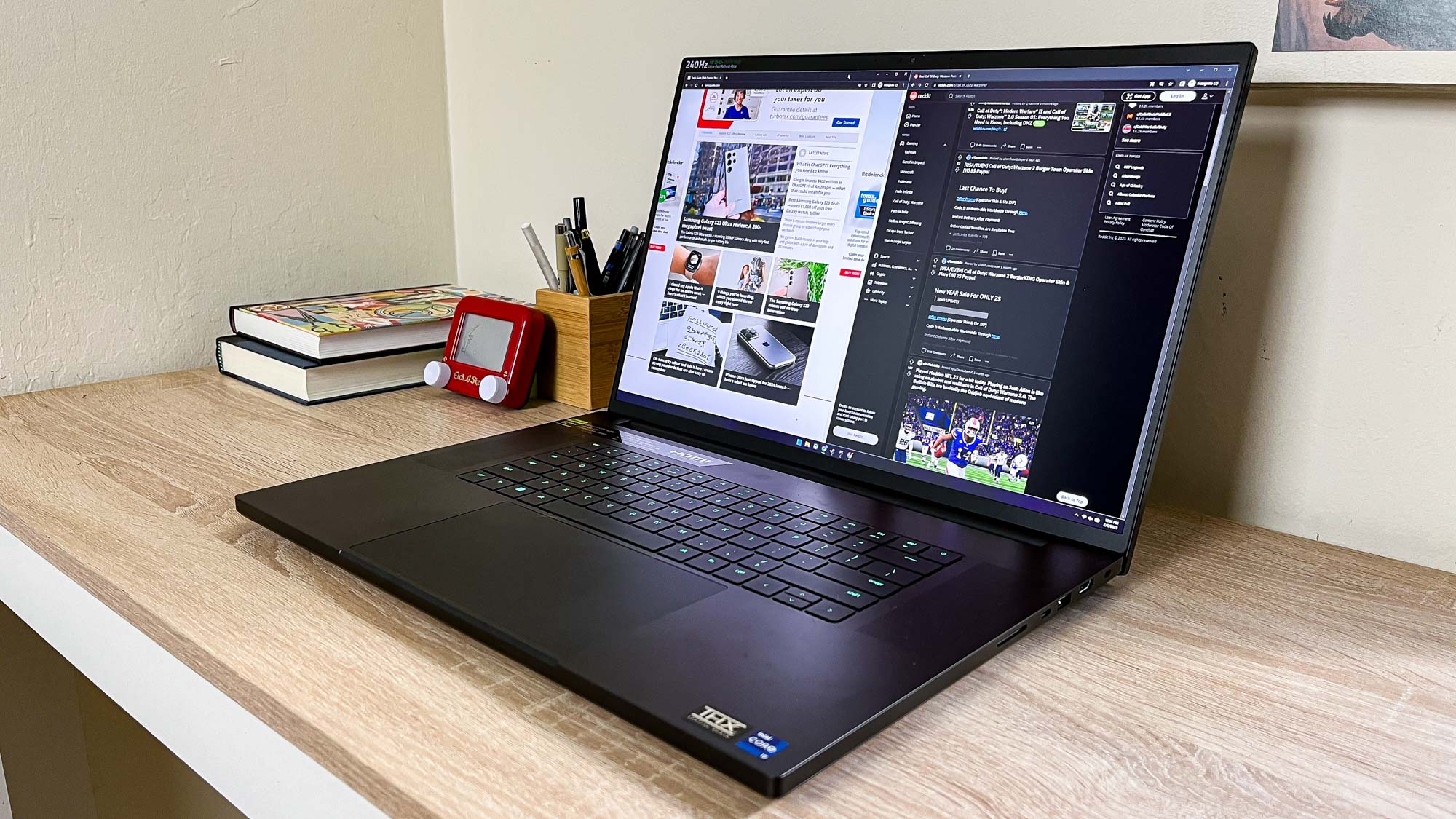
Thankfully, if you pull it out in a coffee shop or a classroom you won't feel too out of place. Gaming laptops are often decked out in eye-catching designs, but the Blade 18 plays it relatively low-key with a simple matte black exterior marred only by a Razer logo on the lid.
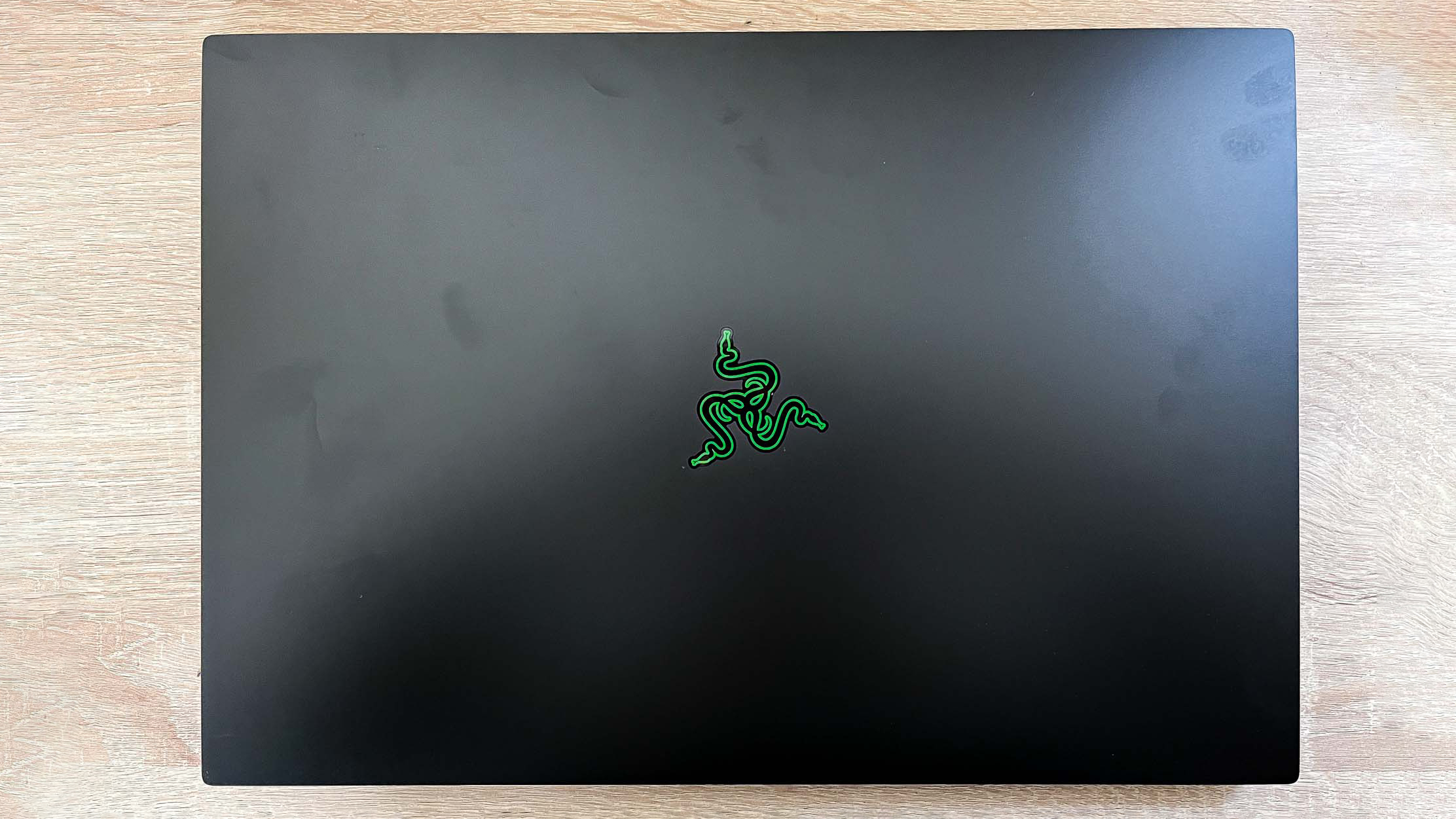
Razer claims the finish has been treated with a fingerprint-resistant coating, but in my experience it's pretty common to find a few smudges on the Blade 18 after you've been using it for awhile.
Razer Blade 18 review: Display
The 18-inch 240Hz QHD+ (2,800 x 1,600 pixels) IPS panel on the Blade 18 looks large and luminous in person. It might look a bit bigger than usual at a distance, but once you sit down in front of it you quickly stop noticing the size of the screen.
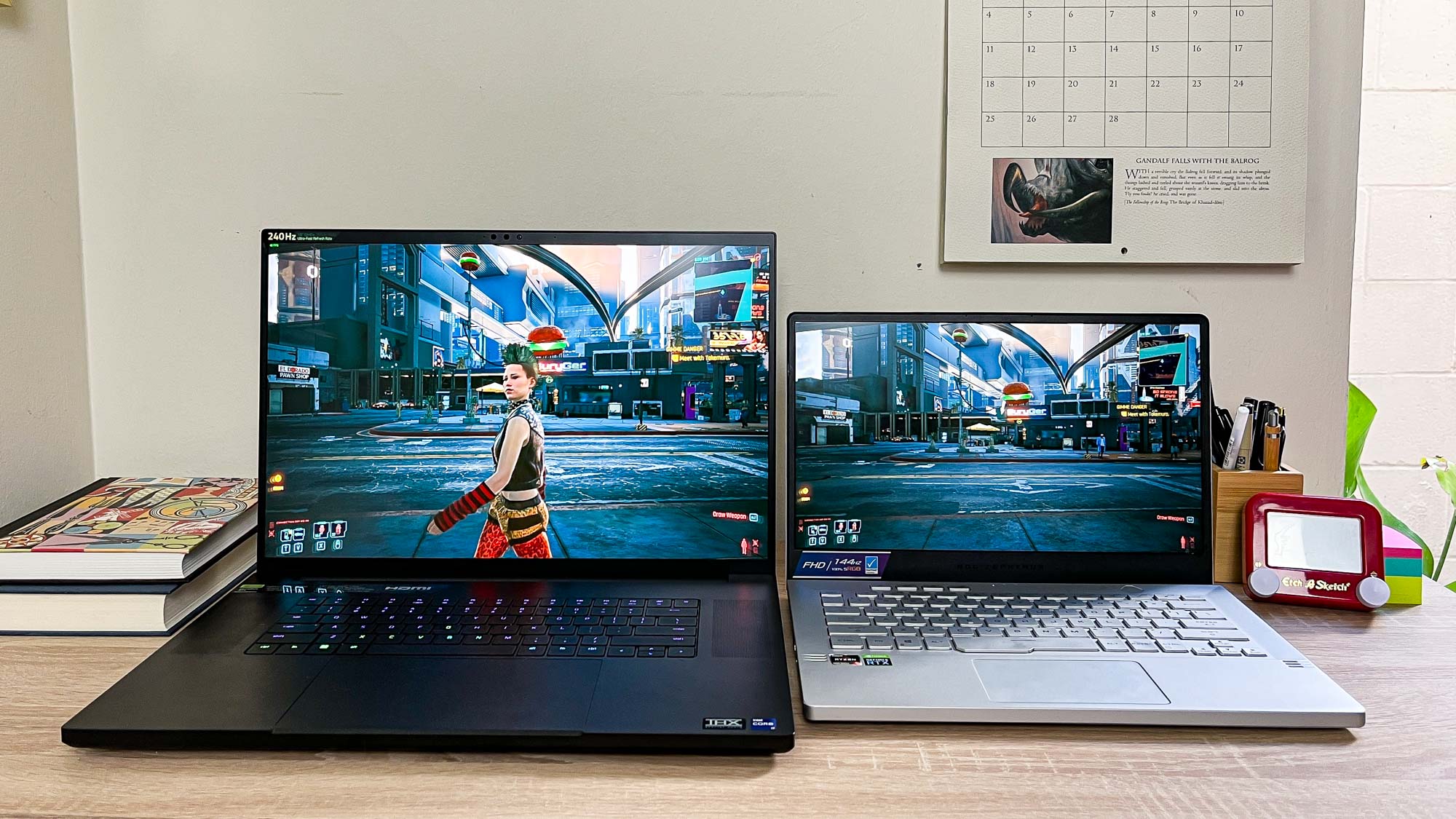
With this much screen space it's not a hassle to keep multiple windows open side-by-side onscreen, making the Blade 18 a nice canvas for multitasking as well as gaming. "
What takes longer to wear off is the novelty of having this much screen real estate on a laptop. It's not a huge upgrade over a good 17-incher like the LG Gram 17, but it is noticeable and nice to have. With this much screen space it's not a hassle to keep multiple windows open side-by-side onscreen, making the Blade 18 a nice canvas for multitasking as well as gaming. And if you're playing fast-paced games at high framerates, the display's 3ms response time and 240Hz refresh rate are key features—though you can choose to automatically limit the display's refresh rate to 60Hz when unplugged to conserve battery.
Heck, the display on the Blade 18 is large enough that text often looks a bit too small to my eyes at its native 2,800 x 1,600 resolution, so I sometimes use Windows' built-in scaling tools to make everything a bit bigger. This is the kind of thing I usually only have to do on laptops with 4K displays (like the Razer Blade 17), so it's interesting to run into the same problem for a different reason.
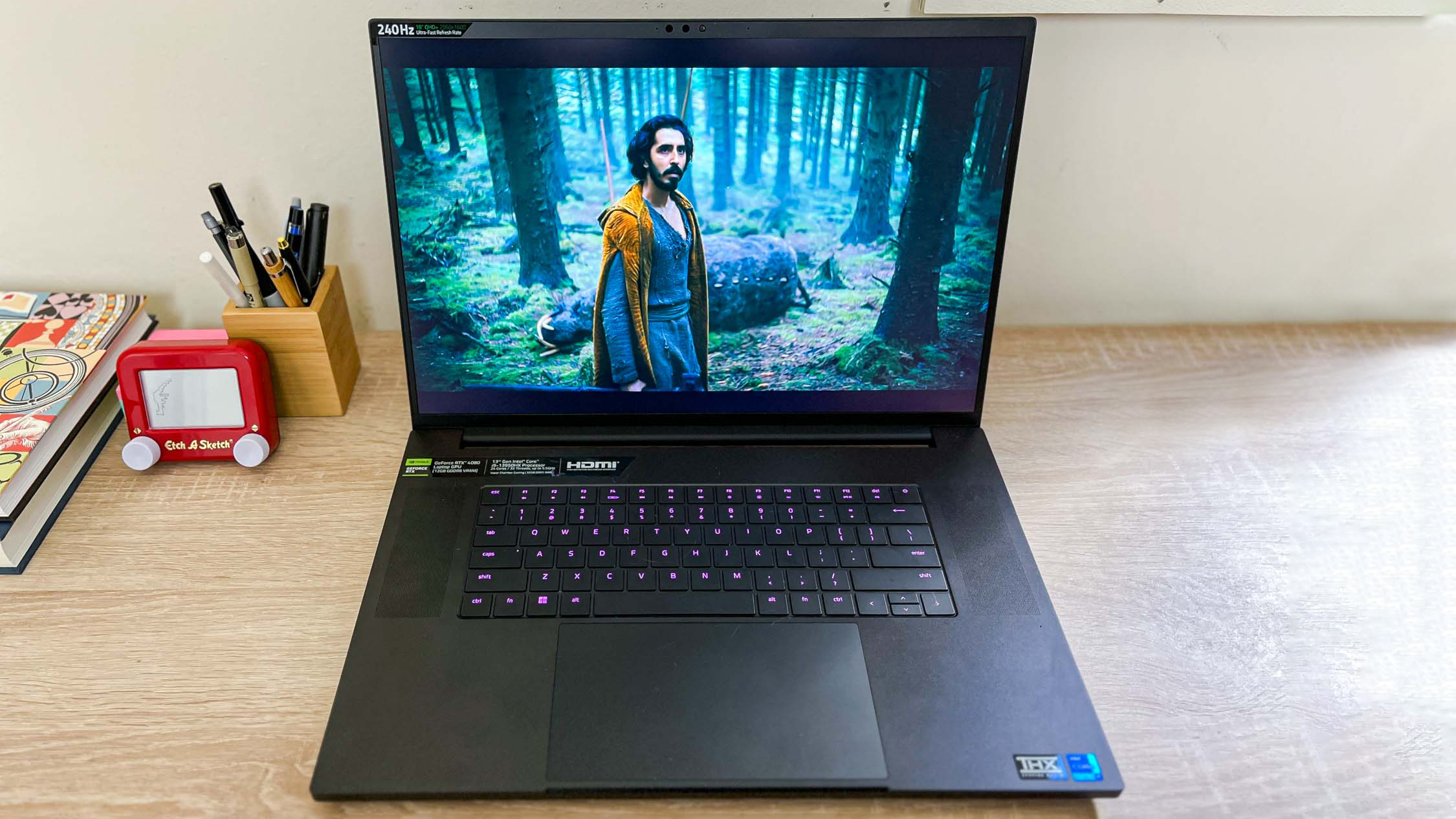
Razer claims the display can achieve up to 100% of the DCI-P3 color gamut, but when we got the Blade 18 into our testing lab and pointed our instruments at it we found the results to be a little lower than that. Our testing suggests it achieves 89% of the DCI-P3 color gamut and 125.7% of the sRGB color gamut (100% is most accurate) with a Delta-E score of 0.26 (the closer to 0 the better).
Our testing also backs up my anecdotal experience that the Blade 18's display is quite bright, as we measured it achieving an average brightness of 495.2 nits, peaking at 513 nits in the center. That's quite luminous and brighter than fellow 18-inch gaming laptop the Asus ROG Strix Scar 18 (average brightness 402.2 nits), though not quite as bright as the 17-inch screen (511 nits) on the MSI Titan GT77 HZ gaming laptop we just tested.
| Row 0 - Cell 0 | Razer Blade 18 | Asus ROG Strix Scar 18 | MSI Titan GT77 HX |
| sRGB color gamut | 125.7% | 109.4% | 161.6% |
| DCI-P3 color gamut | 89.3% | 77.5% | 114.5% |
| Average brightness (nits) | 495.2 | 402.2 | 511 |
Numbers aside, the display on the Blade 18 makes games and videos look great. I enjoyed using all that screen real estate to watch The Green Knight and The Last Duel, which both looked sharp and color-accurate on the Blade 18's display. Games like Cyberpunk 2077, A Plague Tale: Requiem and Phantom Brigade also look bright and vibrant on the screen.
Razer Blade 18 review: Ports
The Razer Blade 18 has a full complement of ports, which is what you'd expect from a laptop this large. They're well-spaced too, so even if you're using many at once you shouldn't have too many cable-routing headaches.
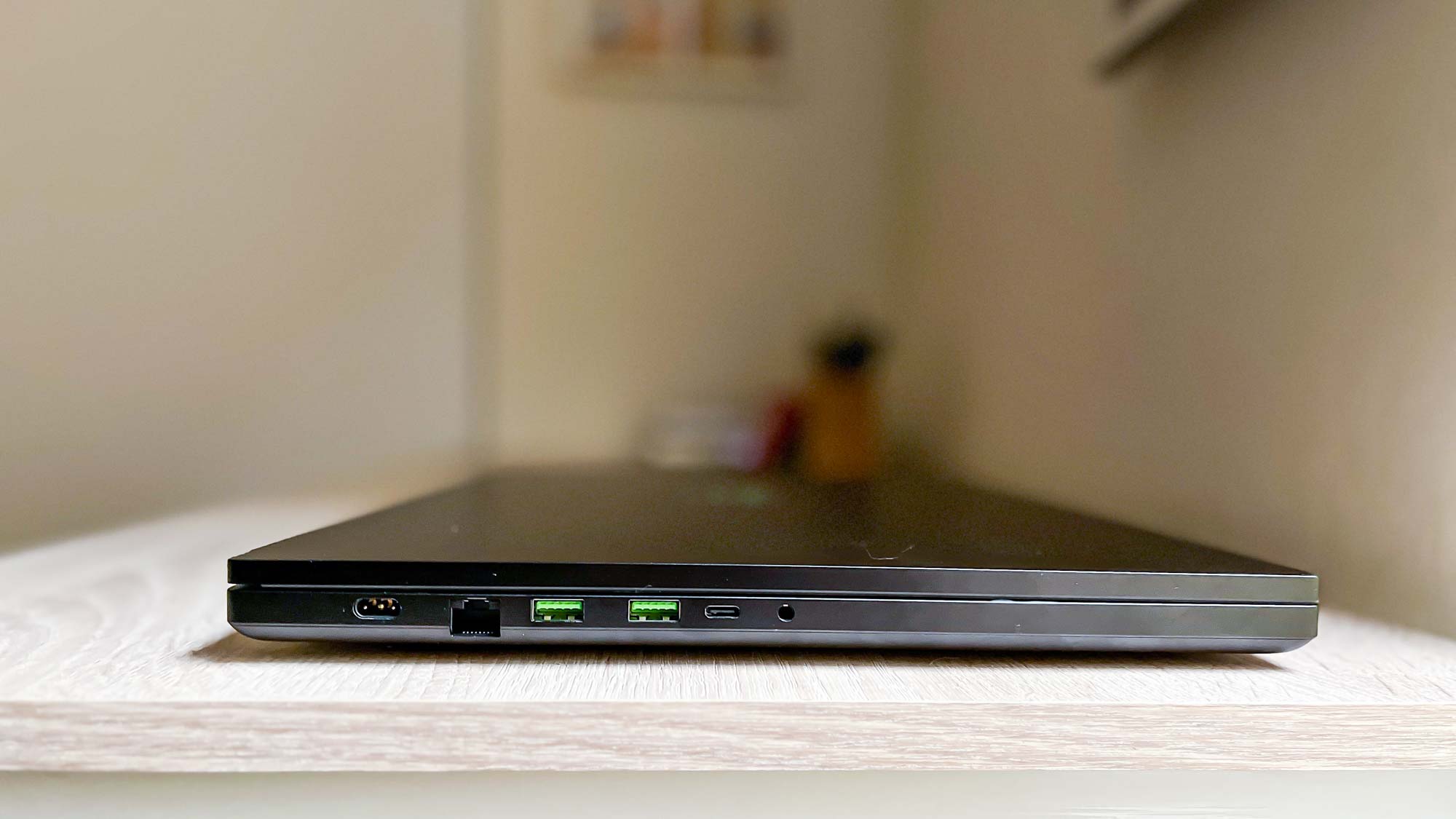
On the left side you'll find a pair of USB-A (3.2 Gen 2) ports, a USB-C (3.2 Gen 2) port, a 2.5Gb Ethernet port, a 3.5mm audio jack and the power port. In a pinch, the laptop can also charge via USB-C.
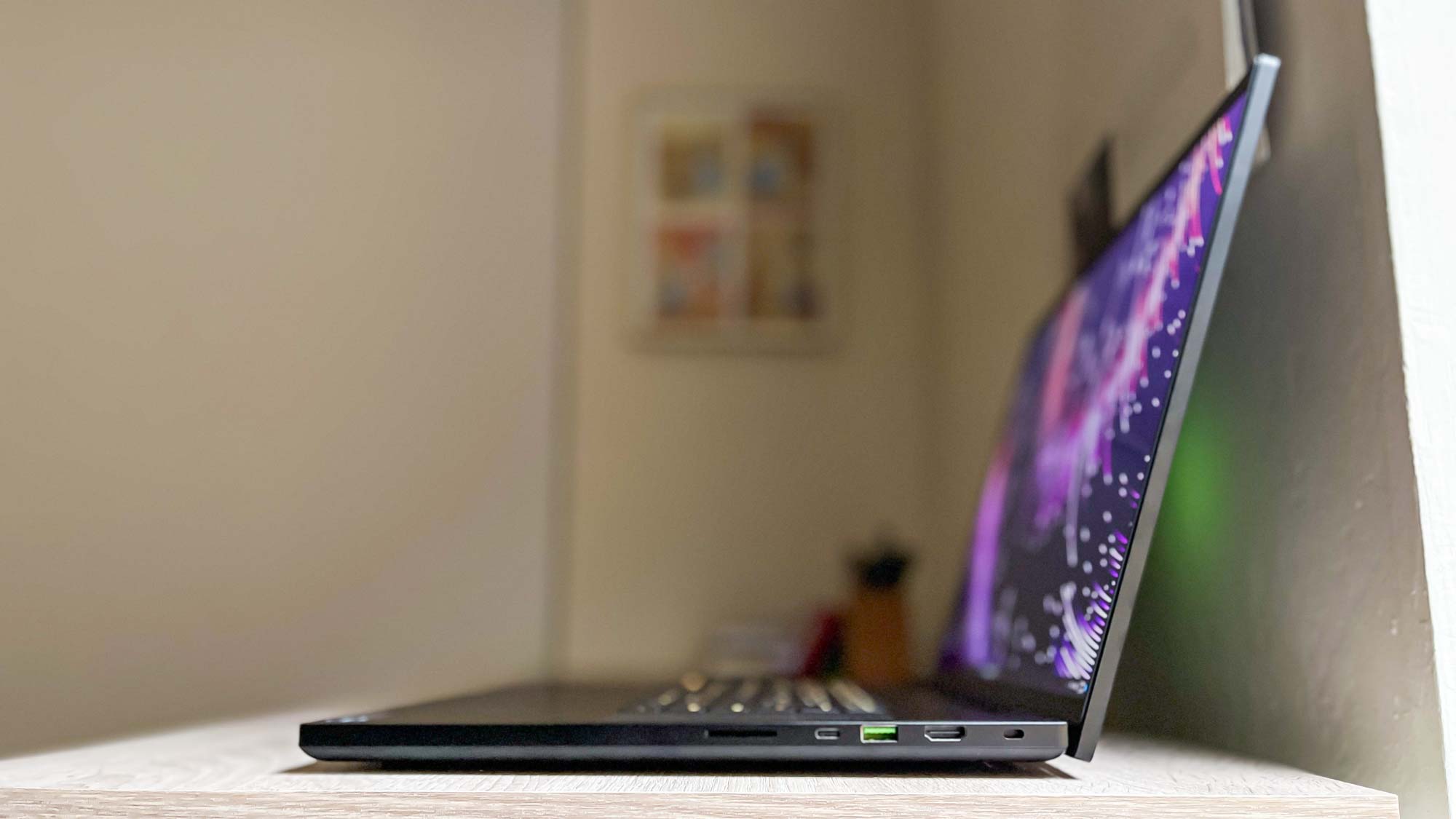
Over on the right side you get another USB-A (3.2 Gen 2) port, a Thunderbolt 4/USB4 port, an HDMI 2.1 out and a UHS-II SD card reader. This is also the side with the slot for a Kensington lock which, given how much this laptop costs, might not be a bad investment.
Razer Blade 18 review: Gaming performance
This big-ass laptop was built for gaming, so let's talk about how well it performs under pressure. I've been using it to play games like Cyberpunk 2077, Doom Eternal, Forza Horizon 5 and Phantom Brigade for hours on end, and I'm impressed at what a difference the large screen makes. It's not a game-changer or anything, but every inch counts on a laptop and you really feel the benefit of the 18-inch display when you're looking across a cityscape in Cyberpunk or panning across a tactical map in Warhammer 40K: Chaos Gate - Daemonhunters.
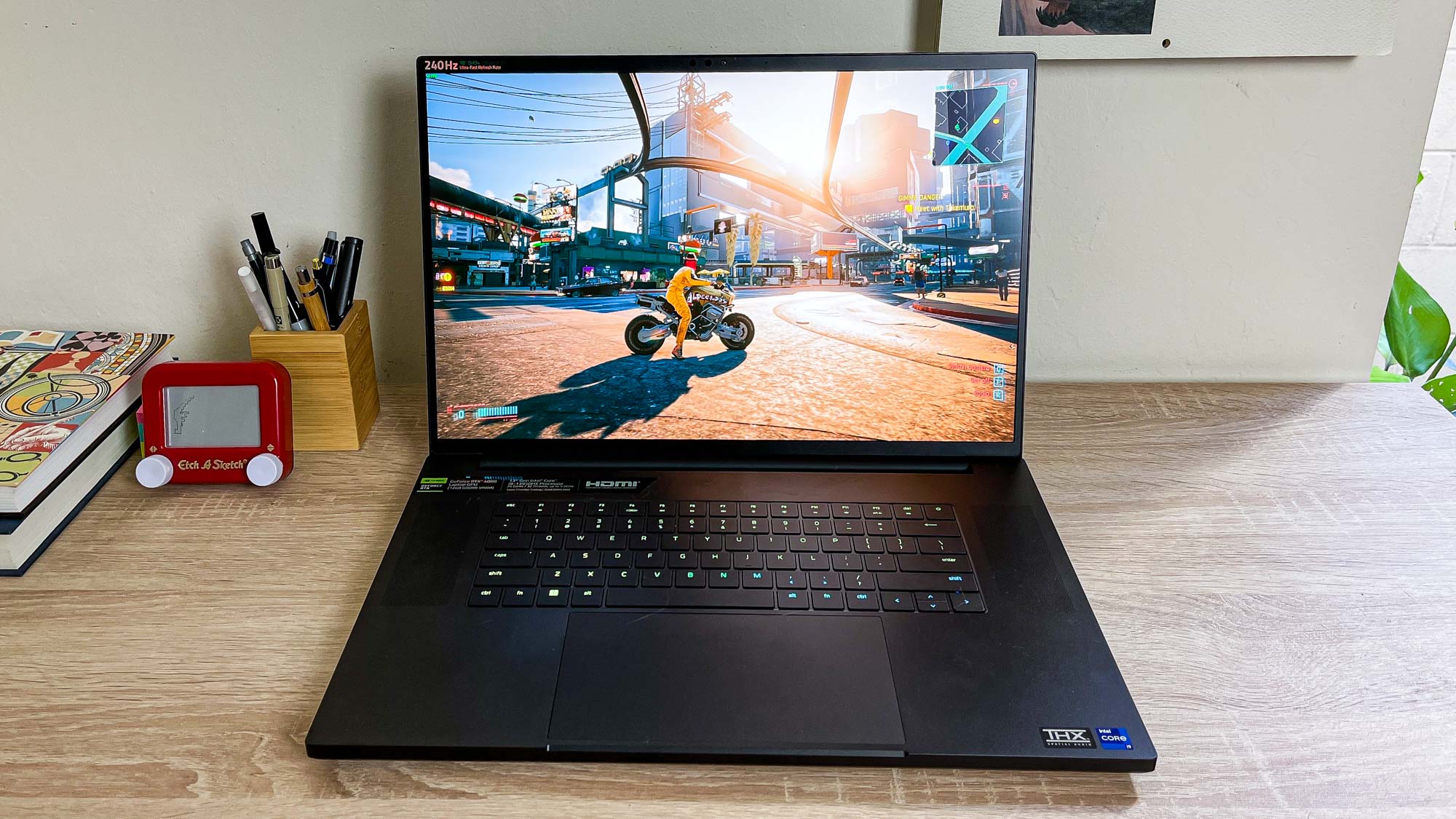
Every inch counts on a laptop and you really feel the benefit of the 18-inch display when you're looking across a cityscape in Cyberpunk 2077."
I will say that even our high-end (though not top-of-the-line) Blade 18 review unit, with its GeForce RTX 4080 laptop GPU, 13th Gen Raptor Lake Intel CPU and 32GB of RAM, struggles to play the latest games at maxed-out settings. When I cranked all the graphical settings up to max in Cyberpunk 2077 (with Nvidia's DLSS 3 disabled), for example, our Blade 18 review unit struggled to maintain 15-20 frames per second in outdoor areas. When I dialed down the settings to Medium the average frames per second jumped up into the low 30s, and when I then switched on DLSS it was able to maintain pretty steady framerates of 30-40 fps.
Of course, Cyberpunk is a demanding game that's less than perfectly optimized. Our Blade 18 review unit delivered better performance in games like Assassin's Creed Valhalla, achieving framerates of 60+ fps at native resolution with the settings cranked up. I mention Cyberpunk so you understand that you shouldn't expect every game you play to run at 60 fps or higher with settings maxed on this laptop. It's a beast, but it's still a laptop, and it can't deliver the same caliber of performance we expect from top-tier gaming PCs.
That said, it does run most modern games quite well and they look very good on the large QHD+ display. You should know that when we unboxed our Blade 18 review unit and started testing it, we kept it on its default settings out of the box. That means the power and performance settings are set to default, medium or Balanced, depending on the setting. It's possible to get a bit better performance out of the laptop by playing with these settings in both Windows itself and Razer's Synapse software, so where possible we re-ran these tests again with as few performance limiters as possible.
Note that we test this way because we presume most readers will want to know how a laptop performs when you take it out of the box and turn it on. It's always possible to try and eke a bit more performance out of a laptop by fiddling with its settings, cleaning out extraneous software and the like, but that's an open-ended and time-consuming effort with variable results.
| Row 0 - Cell 0 | Razer Blade 18 | Asus ROG Strix Scar 18 | MSI Titan GT77 HX |
| Assassin’s Creed Valhalla | 131 | 154 | 124 |
| Far Cry 6 | 90 | 107 | 102 |
| Grand Theft Auto V | 142 | 152 | 176 |
| Shadow of the Tomb Raider | 144 | 180 | 180 |
When we powered up the Blade 18 in its default out-of-the-box state, set it up for testing and ran it through our gaming benchmarks, we saw solid performance across the board. In Assassin's Creed Valhalla, for example, our Blade 18 delivered an average of 131 frames per second at 1080p and 99 fps at its native 2,560 x 1,600 resolution.
To give you a sense of what a difference fiddling with settings makes, we re-ran the Valhalla benchmark after taking some time to do things like set the Blade 18's power management plan to "high performance" and crank the CPU and GPU to max in the Performance Modes section of Razer Synapse. The result? The laptop delivered an average of 9-10 more frames per second of Valhalla at native res, achieving an average of 99 fps at QHD+ resolution.
That's a small but meaningful improvement which shows what kind of payoff you can get from fine-tuning performance settings on your laptop. It's definitely a good idea on the Blade 18, which costs so much that it's worth taking the time to get the best performance you can out of it—especially if you want to play some of the most demanding games.
When we ran Red Dead Redemption 2 with graphical settings set to Ultra on our Blade 18, for example, it managed 48 fps at 1080p and 32 fps at native resolution. Drop the settings down to Medium and those numbers climb to 99 fps at 1080p and 65 fps at native res, which is much better. In the older Grand Theft Auto V, however, our Blade 18 delivered an impressive 142 fps at 1080p and 82 fps at native res.
Those are impressive scores, and they confirm the Blade 18 is a performant gaming laptop. In the chart above we charted the Blade's performance in select games at 1080p versus the performance of two similar recent gaming laptops, the 18-inch Asus ROG Strix Scar 18 and the 17-inch MSI Titan GT77 HX. These are great comparison points because they both have similar 13th Gen Core i9 CPUs and similar RAM counts (32GB in the Asus, 64GB in the MSI). However, the MSI and Asus laptops both pack top-of-the-line Nvidia GeForce RTX 4090 laptop GPUs, while our Blade 18 review unit has the less powerful RTX 4080 onboard. This, and the disparity in RAM, likely explains why these two laptops outperform our Blade 18 in most gaming benchmarks.
Razer Blade 18 review: Overall performance
Sometimes you like to do other things with your gaming laptop besides playing games, which is why we also ran the Blade 18 through our gauntlet of general performance tests. As you might expect, the 13th Gen Intel CPU, GeForce RTX 4080 GPU and 32GB of RAM make this machine plenty competent when it comes time to start multitasking and slinging spreadsheets.
When we put it to the test using the Geekbench 5.4 multicore CPU benchmark, for example, the Blade 18 put up a solid score of 14,070, which jumped up to 17,564 when we cranked all the performance settings up to max.
While that falls short of what other cutting-edge gaming laptops like the Asus ROG Strix Scar 18 (19,233) and MSI Titan GT77 HX (20,602) achieve, it's still plenty faster than even leading ultraportables like the Samsung Galaxy Book 3 Pro 360 (8,250) and even Apple's beefy 16-inch MacBook Pro with M2 Max (15,044).
| Row 0 - Cell 0 | Razer Blade 18 | Asus ROG Strix Scar 18 | MSI Titan GT77 HX |
| Geekbench 5 (artificial performance benchmark) | 14,070 | 19,233 | 20,602 |
| Copying 25 GB (MBps) | 1,637 | 1,885 | 2,299 |
| Handbrake video encoding (minutes:seconds) | 4:56 | 2:49 | 2:38 |
If you're considering cutting video with the Blade 18, you should know it's a solid workhorse that completed our video encoding speed test (which tasks the laptop with transcoding a 4K video down to 1080p via Handbrake) in 4 minutes 56 seconds. That's quite a bit slower than competing gaming laptops like the Asus ROG Strix Scar 18 (2:49) or the MSI Titan GT77 HX (2:38), but faster than most non-Apple laptops. The Samsung Galaxy Book 3 Pro 360, for example, completed the same task in 7:59.
The SSD inside is pretty speedy too, as we measured it achieving transfer rates of up to 1,637 MBps while copying 25GB of multimedia files. Here again the Asus ROG Strix Scar 18 (1,885 MBps) and MSI Titan GT77 HX (2,299 MBps) and their 2TB SSDs are faster than the 1TB SSD inside our Blade 18.
In my personal hands-on experience using the Blade 18 for work and play, I can tell you it never faltered in my day-to-day tasks. I was able to regularly run multiple browsers (we were testing some stuff in Edge and Chrome) with 30+ tabs open, while streaming music via Spotify and playing games in a window, and the Blade handled it all with zero slowdown and as much aplomb as a matte black laptop can manage.
Razer Blade 18 review: Keyboard and touchpad
The deck of the Razer Blade 18 is inset with a tenkeyless keyboard sporting some bells and whistles for game enthusiasts. While it's not mechanical, the keyboard offers anti-ghosting tech and customizable per-key RGB lighting. In my experience it's a completely usable, if slightly uncomfortable, keyboard.
The key travel is too shallow for comfort and the keys themselves are so low-profile as to make it hard to orient my hands on the keyboard purely by touch. Instead, I kept catching myself looking down to see where my hands were placed while playing games, which was a hassle.
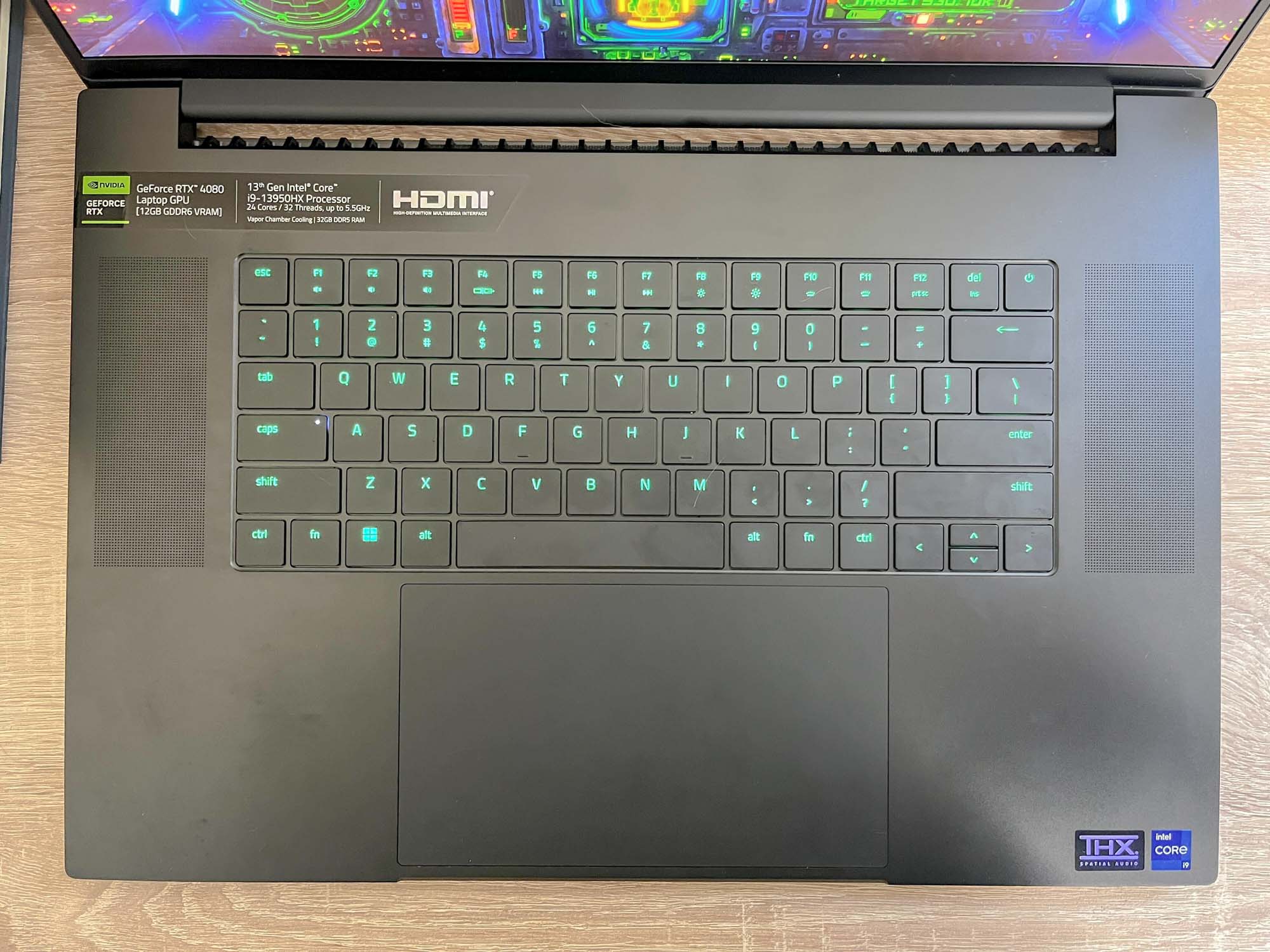
The touchpad is quite big, with Razer claiming it's 50% larger than the touchpad on the Razer Blade 17. There's not much to say about it besides that it works and works well, as I had no trouble using it to execute Windows gesture commands or move the camera around in a slow-paced game like Sid Meier's Civilization VI. I did occasionally have trouble getting it to register my left-clicks, which I soon realized was because it's so big I was inadvertently clicking the center of the touchpad, rather than the lower left.
Of course, most PC game enthusiasts will choose to plug in their own gaming mouse and keyboard rather than rely on the Blade 18 itself. This doesn't excuse Razer from not equipping this laptop with a more comfortable and satisfying keyboard, but it does mean I feel fine recommending you hook up your own keyboard and mouse instead. If you're shopping for new gear, check out our guides to the best gaming keyboard and best gaming mouse.
Razer Blade 18 review: Audio
Razer outfitted the Blade 18 with a six-speaker setup, including 2 tweeters and 4 woofers. It supports THX Spatial Audio and can get quite loud, as my neighbors might attest if I had the courage to go and ask them. Obviously without a proper subwoofer you're not getting much in the way of bass out of these speakers, but they do make music and sound effects in games sound nice and clear.
I can't tell you I was able to pick up the location of enemies based purely on their footfalls in Call of Duty: Warzone, but I can tell you gunfire and explosions sounded nice and loud coming out of the Blade 18's speakers. Tracks from artists like The Mountain Goats, Open Mike Eagle and Phil Collins also sounded clear and loud coming out of the Blade 18, and while I'm no audiophile I can tell you my music sounded louder and better playing on the Blade 18 than it does on smaller ultraportables like the Microsoft Surface Laptop 5 and Dell XPS 15. It can't match the sound quality of the speakers on Apple's MacBook Pros, however, at least not to my ears.
Razer Blade 18 review: Webcam
The 5MP webcam built into the Blade 18 is better than it has any reason to be, delivering sharp, clear pictures and video.

It made me look as good as I ever could in my weekly calls with colleagues, and I didn't notice any meaningful noise or distortion. While you might want to invest in one of the best webcams if you want to stream yourself playing games on camera, the built-in webcam on the Blade 18 should work pretty well in a pinch.
Razer Blade 18 review: Battery life and heat
Don't expect much in the way of battery life from the Razer Blade 18. Gaming laptops rarely perform well in this department, and that giant 18-inch display isn't helping anything.
In our battery test, which tasks a laptop with continuously surfing the web via Wi-Fi with its screen set to a specific brightness level, the Blade 18 lasted a decent 5 hours and 20 minutes. That's terrible for most laptops but not bad for gaming laptops, which tend to be power hogs even when not gaming. In this test the Blade 18 outpaced the old Blade 17 (3:52) and the new Asus ROG Strix Scar 18 (4:26), but not the Asus ROG Zephyrus G14 (10:14), our current reigning champ as far as long-lived gaming laptops go.
When we ran a more graphically-intensive PCMark 10 benchmark to simulate how long the Blade 18 lasts while gaming on battery power, we saw that time plunge to 1:35. This is par for the course for gaming laptops, which rarely last more than an hour or two when gaming on battery. However, the Blade 18 did slightly outlast the Asus ROG Strix Scar 18 (1:26) in this test, as well as its smaller siblings the Blade 15 (1:04) and the Blade 17 (1:19).
| Row 0 - Cell 0 | Productivity test | Gaming test |
| Razer Blade 18 | 5:20 | 1:35 |
| Asus ROG Strix Scar 18 | 4:26 | 1:23 |
| MSI Titan GT77 HX | 3:48 | 1:44 |
As far as heat goes, the Blade 18 gets quite toasty when running at full throttle. In our standard heat test (which involves playing an HD video for 15 minutes, then scanning the laptop with a heat gun) we found the Blade got as warm as 105 degrees on the underside, peaking at 108.9 degrees at the rear of the underside where the heat vents.
Temps like that can make this massive laptop feel even more uncomfortable in your lap, cementing its reputation as a desktop replacement rather than a portable gaming machine. But when we actually ran some modern games on it and then scanned it with our heat gun, we really saw temperatures climb. After a bout of gaming the Blade 18 got as hot as 105 degrees on top and 113 degrees on the bottom, peaking at 133.2 degrees along the rear underside.
That's bona fide lap-scorcher territory, so we strongly recommend against trying to play Cyberpunk 2077 or Doom Eternal with this thing in your lap.
Razer Blade 18 review: Verdict
The Razer Blade 18 is a great gaming laptop that makes a compelling case for why you should pay so much money for a portable PC with such a large 18-inch display.
There's real value to having a PC this powerful that you can pick up and take with you without having to worry about a case, cables, a monitor or anything else. I know that college students can make great use of a desktop replacement like this, for example, because I did exactly that when I was in school. When you want to invest in a gaming PC but you also know you'll be moving house every year or more, a gaming laptop looks awfully compelling.
The Blade 18's extra-large screen makes it even better-suited to standing in for a full desktop, since the display feels nearly as spacious as a full 24-inch monitor. And with the latest Nvidia GeForce RTX 40-series laptop GPUs and Intel's new 13th Gen CPUs onboard, the Blade 18 can deliver the kind of performance we used to only dream of achieving with a laptop.
There's no doubt in my mind that the Blade 18 is one of the best 18-inch laptops you can buy, but that's due in part to the fact that there aren't many on the market right now. Once they start arriving in greater variety, the Blade's high price and slightly underwhelming performance may give you cause to consider a competitor. The Asus ROG Strix Scar 18 we're in the process of reviewing right now, for example, delivers better performance than the Blade 18 in nearly every game thanks to its beefier components (an RTX 4090 GPU and Core i9-13980HX CPU) and offers double the storage space, yet retails for just over $100 more ($3,900 vs. $3,799 for the Blade 18).
Of course, the Blade 18 lasts slightly longer on a charge and is slightly thinner than the Asus 18-incher, and to my eyes it looks nicer to boot. So in the end it really comes down to how much you're willing to spend and what features matter to you most. If you want a slick-looking 18-inch gaming laptop with solid performance, plenty of ports and a beautiful display, the Razer Blade 18 is a great choice.

Alex Wawro is a lifelong tech and games enthusiast with more than a decade of experience covering both for outlets like Game Developer, Black Hat, and PC World magazine. A lifelong PC builder, he currently serves as a senior editor at Tom's Guide covering all things computing, from laptops and desktops to keyboards and mice.
